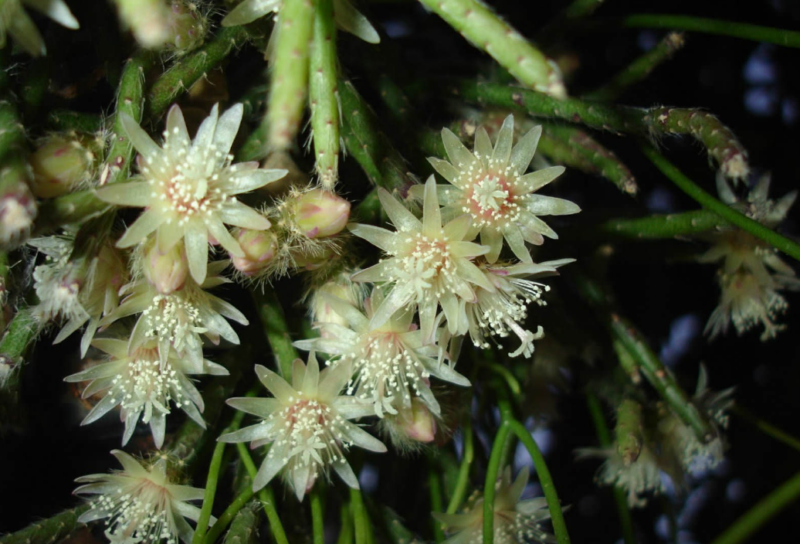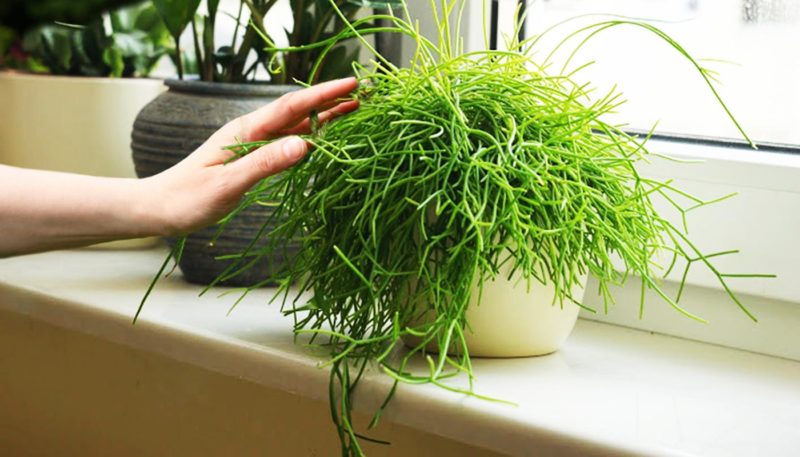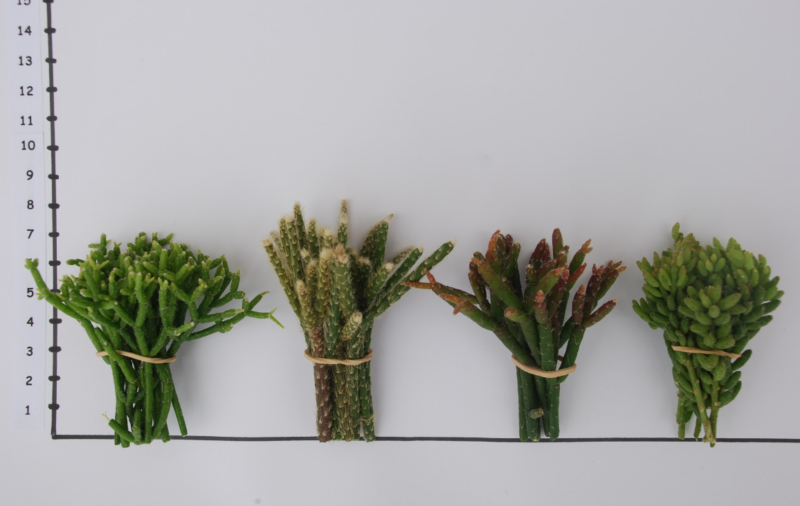Ripsalis is a well-known ornamental plant that belongs to an extensive and very common cactus family. Inexperienced florists often confuse ripsalis with hatior, but in reality they are two completely different plants. In the collection of each grower, there must be such an exotic as ripsalis.
Material Content:
Description and habitat of the plant
These epiphytic cacti in the wild grow in India and America. The long shoots of tropical ripsalis is his calling card, because in the translation “Rhipsalis” means ornate. Some varieties on the segments have pubescence.
The color of the stem depends on the type of culture, therefore it can be juicy green or even gray-blue. Many varieties sometimes settle on the bark, and rush down its ornate tubules-stems down it.
Cactus blooms in small buds, which are cream, yellow, pinkish, red or white. After flowering, a berry is formed, which is similar to the fruits of gooseberries.
Varieties of Ripsalis
Gobelian ripsalis stems sometimes reach 60 centimeters. This culture also blooms with small graceful flowers; shoots are collected from individual segments that have an oval shape.
Hairy Ripsalis forms a lush bush, as if falling from a cache-pot. It blooms with very small creamy white flowers.
Lindberg’s view looks very unusual. Its shoots reach a meter and look like threads. The flowers of the variety are creamy with a pinkish glow.
Ripsalis Kassuta, which can often be found in the collections of florists, looks very decorative and elegant. This hanging plant culture blooms extremely beautifully in late spring.The plant forms drooping shoots, which can reach 4 meters. The flowers are very fragrant. After flowering, decorative red fruits are formed.
Another very beautiful view of ripsalis is the ceresusculus, expelling long and thin shoots that are divided into segments. In winter, this variety blooms with pink buds. The petals of the inflorescences are very narrow. Cereusculum ripsalis is very rarely grown in room culture.
Basic landing requirements
The presented ornamental plant can be called unpretentious, but nevertheless, for its good growth, certain conditions must be created.
Cactus does not like heat at all, which is surprising. During the growth period, which begins in the spring and ends in the fall, the temperature in the room should be maintained at about +20. In winter, it requires a cooler atmosphere with temperatures up to +15, so that the plant rests well and restores strength.
The air should be humid in the room, otherwise the flower will not grow. The airy roots of the plant absorb moisture, and therefore it should be irrigated on hot days. Water should be left standing for a long time or at least filtered. In winter, you do not need to spray the cactus.
Some varieties of ripsalis stretch upward during growth, while others, on the contrary, hang down. Therefore, depending on the type, an exotic flowerpot should be placed below the windowsill and installed supports, or suspended in a pot.
It is advisable to place a tropical pot in a shaded place, as the culture does not tolerate direct sun. Comfortable conditions will help create blinds or curtains.
It is very important not to rearrange the pot too often, since such movements are unnecessary stress for the cactus, after which it takes too long to recover.
The soil in which the cactus will grow must necessarily be very loose, and at the same time a slightly acidic reaction. The soil mixture, which contains sand and turf, is perfect. It is easy to prepare the soil by yourself, mixing peat, soil and sand in equal proportions. We must not forget about good drainage in the flowerpot, as ripsalis does not like stagnation of moisture near the roots.
How to care at home
This exotic ampel plant is completely capricious in care, and needs ordinary procedures.
During growth and flowering, it is necessary to provide regular watering. The flower is irrigated very abundantly, but it is ensured that the plant does not “float”. If you keep ripsalis constantly in very moist soil, then its roots will rot.
During the period of rest in the winter, the flower is watered very rarely, making sure that the lump of land in the flowerpot does not dry out completely.
Once or twice a month during active growth, fertilizing is necessary. Ripsalis can be fertilized with special mixtures for cacti.
The dose of fertilizer should be taken half as much as stated in the instructions.
The fact is that an excess of nutrients, especially nitrogen, can adversely affect cactus growth.
A transplant is performed when absolutely necessary. Typically, for young plants, the procedure may be needed only two years after planting. Old specimens are transplanted only once every 5 years. The roots of a tropical cactus are very brittle, so all the required measures must be carried out with extreme caution.
Propagation of the ampel plant
Not everyone decides to breed cactus repalis, the reproduction of which, although available at home by cuttings or seeds, is still fraught with some difficulties. The easiest way to plant a flower is cuttings.
This requires separating the stalk from the bush about 15 cm long. The cut must be sprinkled with charcoal. Then the shoot is rooted in moist soil. It is necessary to keep the seedling warm. Any temperature changes are detrimental to a young plant. Only a month later, the stalk will give the first roots and it can be planted.
It is very difficult to propagate ripsalis with seeds, since the seeds have a very low germination. Be sure to sow exclusively fresh material.First, the seeds are soaked in lukewarm water for 2-3 hours, and then sown and sprinkled with soil 1 cm thick.
Be sure to tighten the container with foil to create a greenhouse effect. The container should be in a dark room with an air temperature of about +20. After the top layer of soil in the tank dries, it must be moistened with a spray bottle. Only after a month and a half will the first sprouts appear. When the plant reaches 2 cm, they are planted in separate small pots.
Diseases and Pests
Home care for this exotic plant also consists in preventing the occurrence of possible ailments and combating parasitic insects.
Of the common pests, scaleflies and spider mites sucking juices from shoots can attack the flower. You can understand that a flower has been attacked by insects by sticky traces. In the store you need to purchase special insecticides against all types of pests that parasitize on indoor plants. Use drugs only strictly following the instructions.
The plant is sick mainly due to florist care errors. If the culture lacks light, flowering will be delayed or it will begin to lag behind in growth. More bushes drop segments due to the low temperature in the room. From the overflow, the flower ducts may begin to frown. Due to lack of moisture, it dries.
On average, a ripsalis cactus or twig, lives 12-15 years. Some gardeners compare this plant with a marine or even an alien phenomenon. Indeed, exotic ripsalis is a very unusual plant that impresses with its unique appearance.
If you learn how to properly care for this type of cactus and create optimal conditions for growth, a luxurious pet will certainly become an exotic decoration of any room in the house.


















